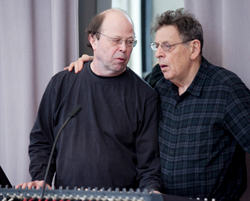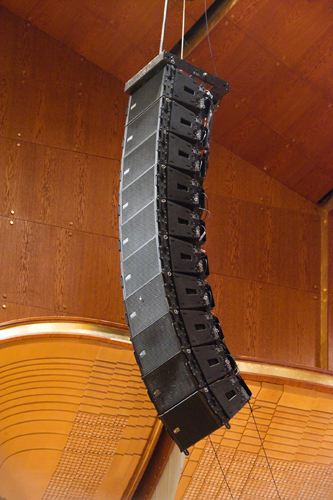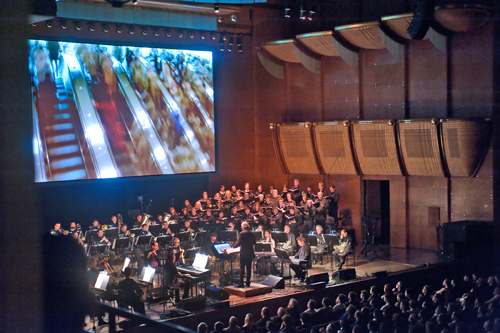
“The arrays had no problem throwing all of the way to the back row of the top balcony without any need for delay fills. We had plenty of power for the space,” Dryden states.
The mains were joined by four RCF TTS56-A dual 21-inch subwoofers, two side-by-side on each side of the stage, and each of these sub sets hosted a single TT25 compact powered loudspeaker supplying in fill presence, particularly for higher frequencies.
The house loudspeaker complement was completed with front fill via four TT052-A low-profile 2-way loudspeakers deployed evenly along the front lip of the stage.
The ensemble, positioned centrally on stage, was comprised of eight players, including three on keyboards, three more on woodwinds, one soprano vocalist, and for this show, a bass vocalist. The orchestra’s 30-piece string section and 19-piece brass section, as well as the 40-member choir, resided in a semi-circle around them.
Each string instrument – violas, cellos and double bass – was outfitted with a DPA 4061 omnidirectional miniature clip-on microphone, while Sennheiser MD 421 II dynamic mics were stand-mounted for each trumpet, trombone, French horn, bass trombone and tuba in the brass section. Each two vocalists of the choir shared a Shure SM58 mic, also stand-mounted.

The ensemble feeds went directly to both front-of-house and monitor consoles, with Dryden manning a Yamaha PM5D board for house and Stephen Erb on another PM5D for monitors.
All of the orchestra and choir feeds (more than 80), meanwhile, routed to a DiGiCo D1 Live console. There, Dan Bora did a mix of the individual stems that were then supplied to the house and monitor consoles.
“One big challenge for a performance of this scale is the number of inputs,” Dryden notes. “In this case we decided to utilize a sub mix, which ended up being a very big job. Not only did Dan Bora have to make sure signal integrity and placement of each of the microphones were good, but the mixes provided to house and monitors were key to the sonic performance.”
All effects were supplied via the PM5D consoles with the exception of a Lexicon 300 reverb at front-of-house that Dryden likes to apply to certain passages or sections.

“The Lexicon algorithms are excellent,” he says. “I’ve used Lexicons forever – for me they’re the smoothest, best-sounding digital reverbs.”
Monitor engineer Erb fed mixes to 12 dBTechnologies DVX D12 powered 2-way loudspeakers that acted as stage monitors for the ensemble – keyboards, woodwinds, soprano vocal and bass vocal.
The strings, brass and chorus sections were served monitor mixes with stand-mounted dBTechnologies K70 multipurpose ultra-compact loudspeakers (also powered).
Dryden reports that the project produced the results he was seeking. “I think it’s always important to remember that you need to work with a room rather than try to impose your will upon it,” he concludes. “In this case, it’s a terrific room and, when equipped with the right system, it sounded fantastic. The musicians in the symphony and the chorus added so much to the ensemble’s performance. It all added up to a lot of fun.”
Julie McLean Clark is a writer and marketing consultant working who has worked in the pro audio industry for more than 15 years.
